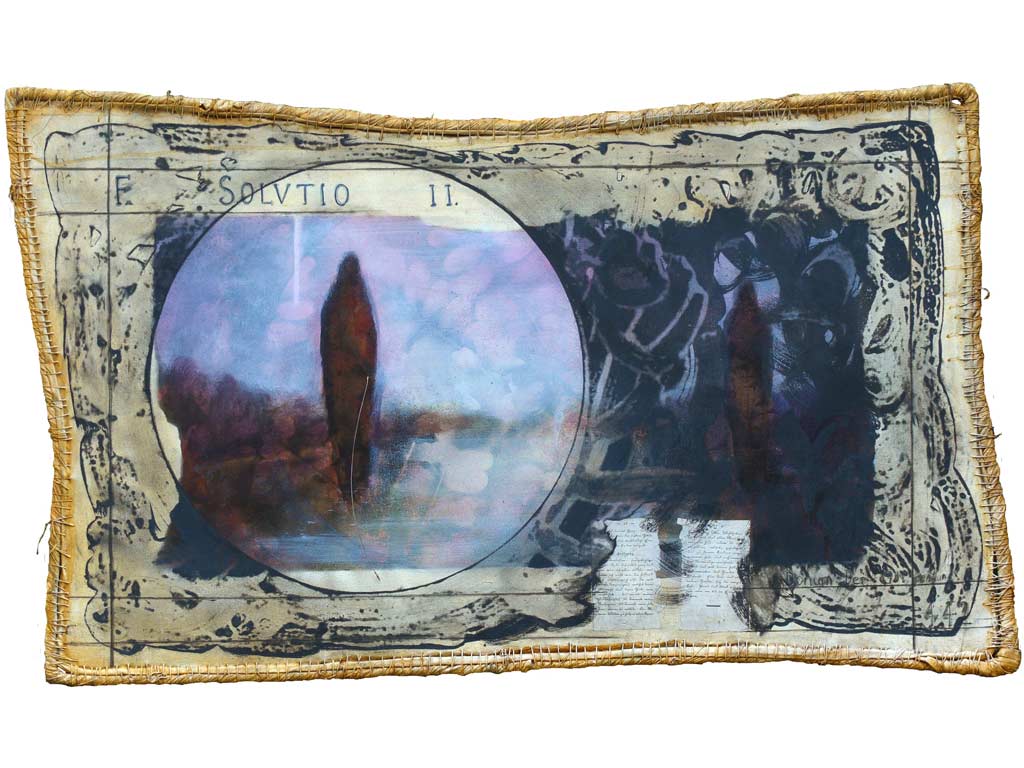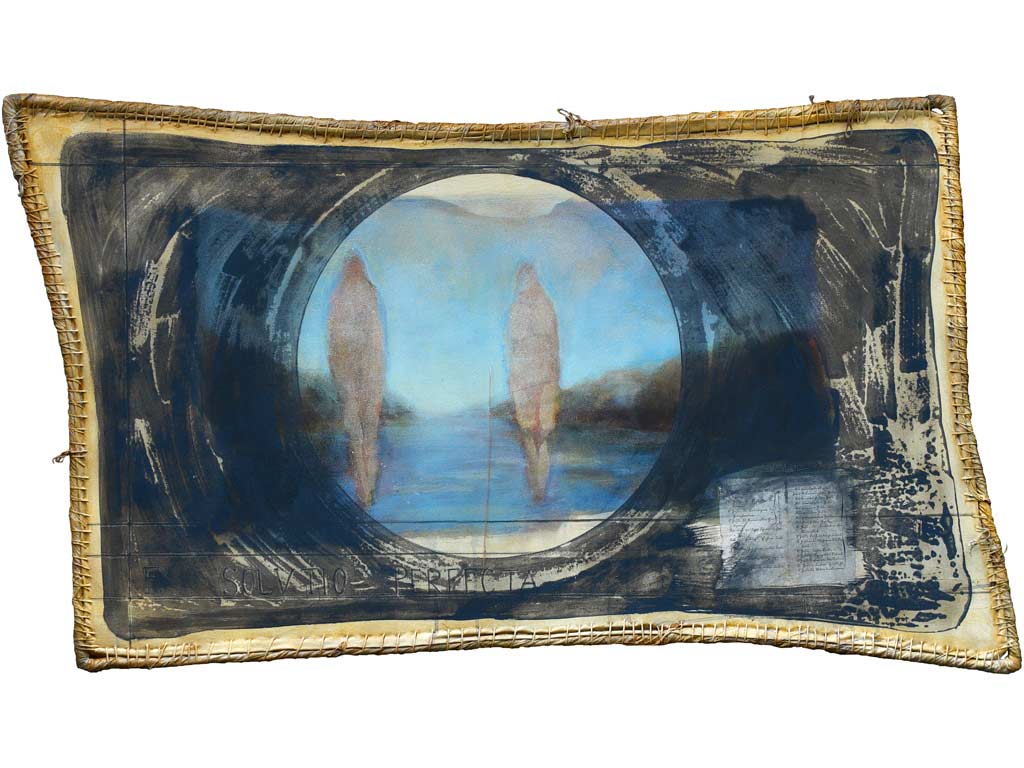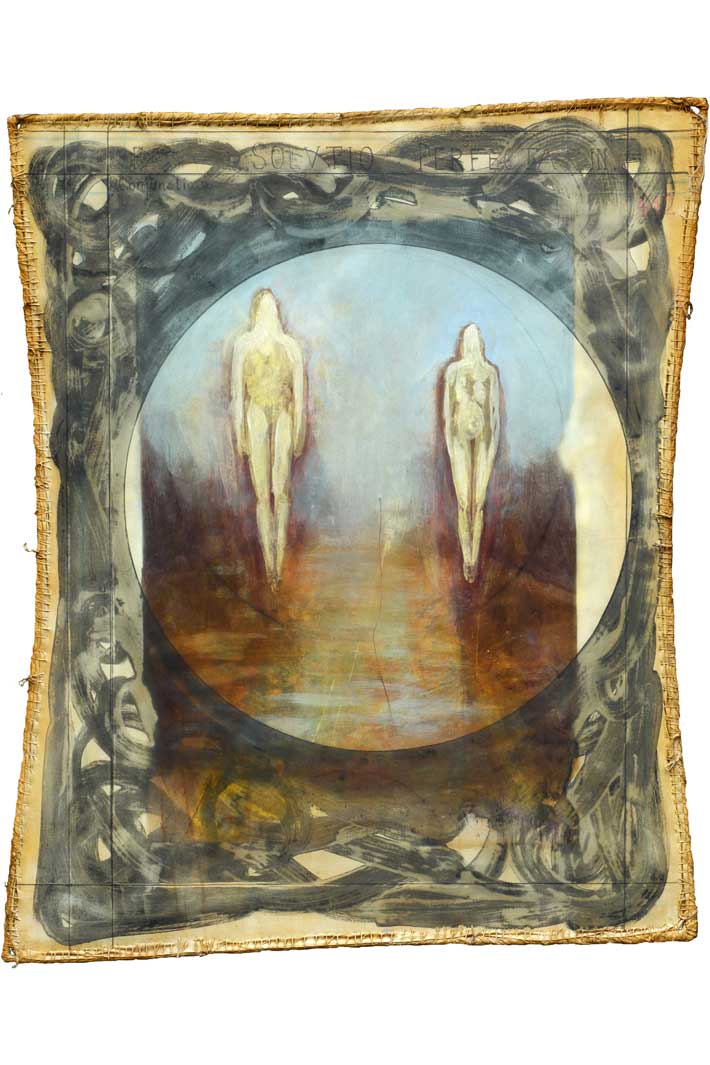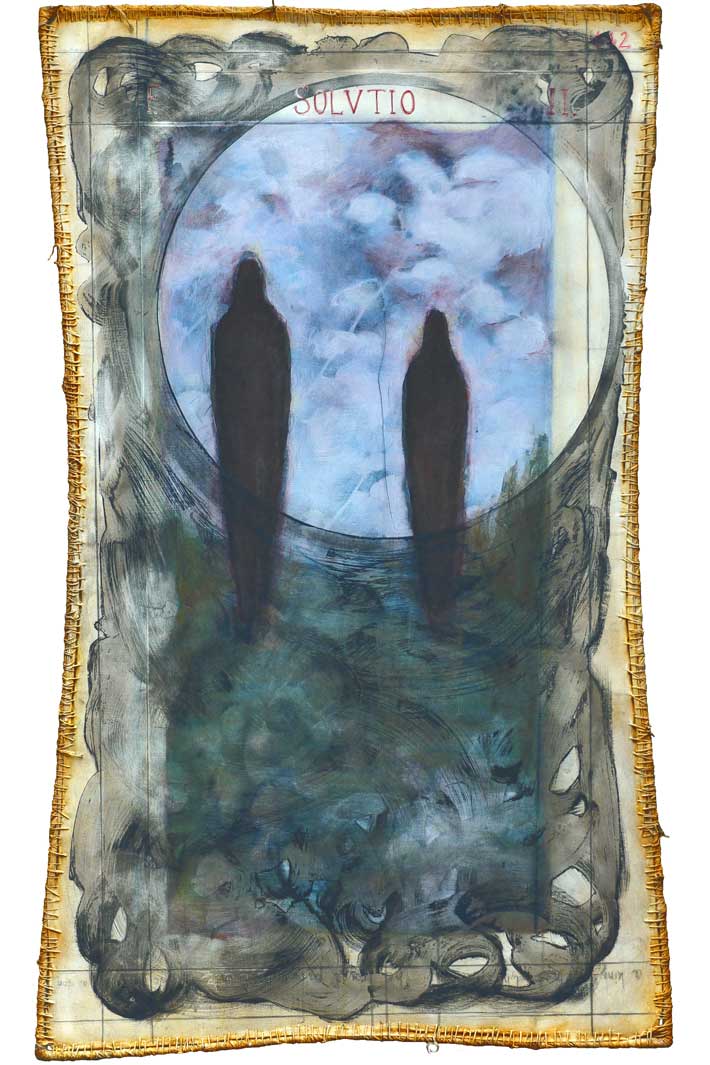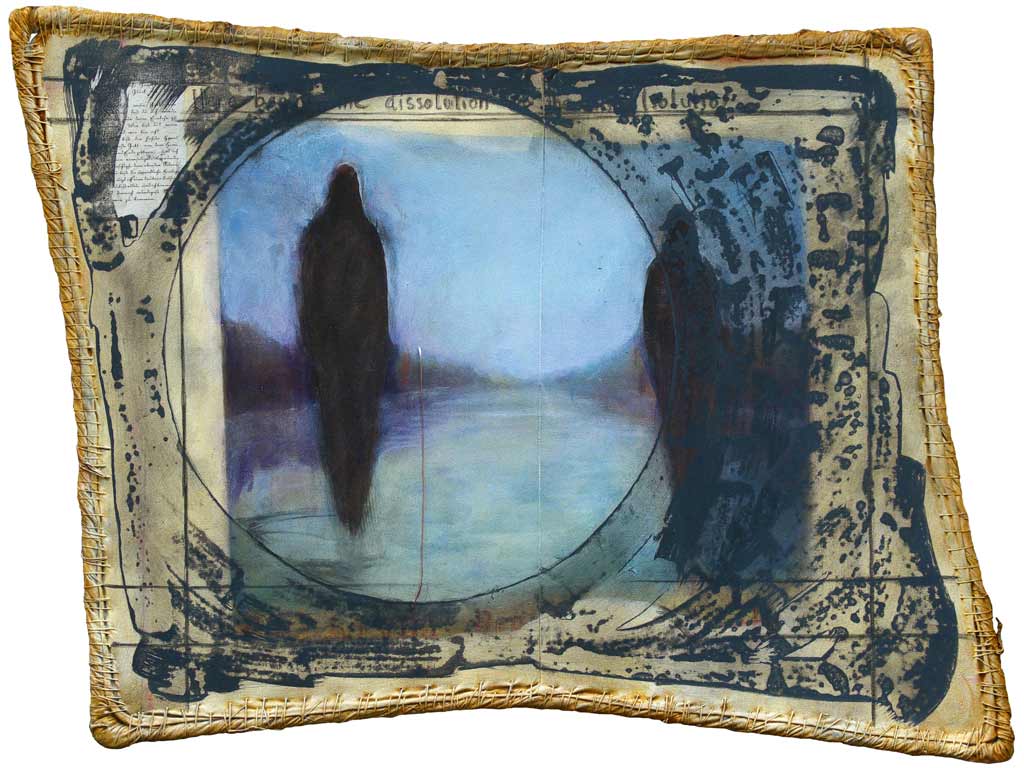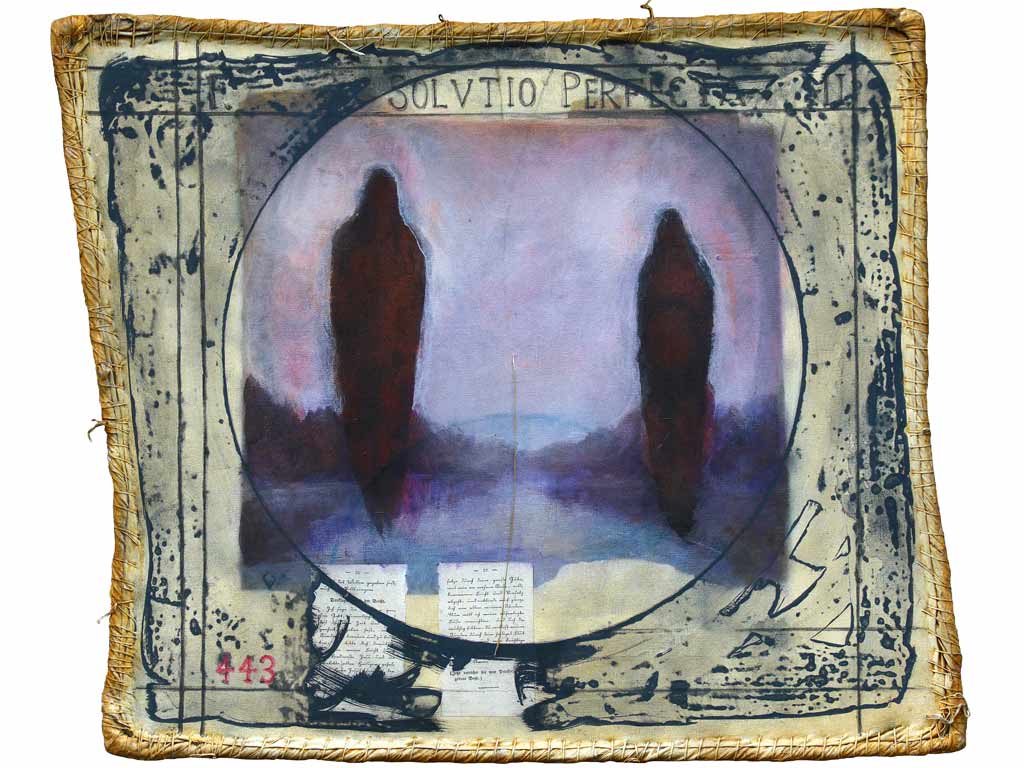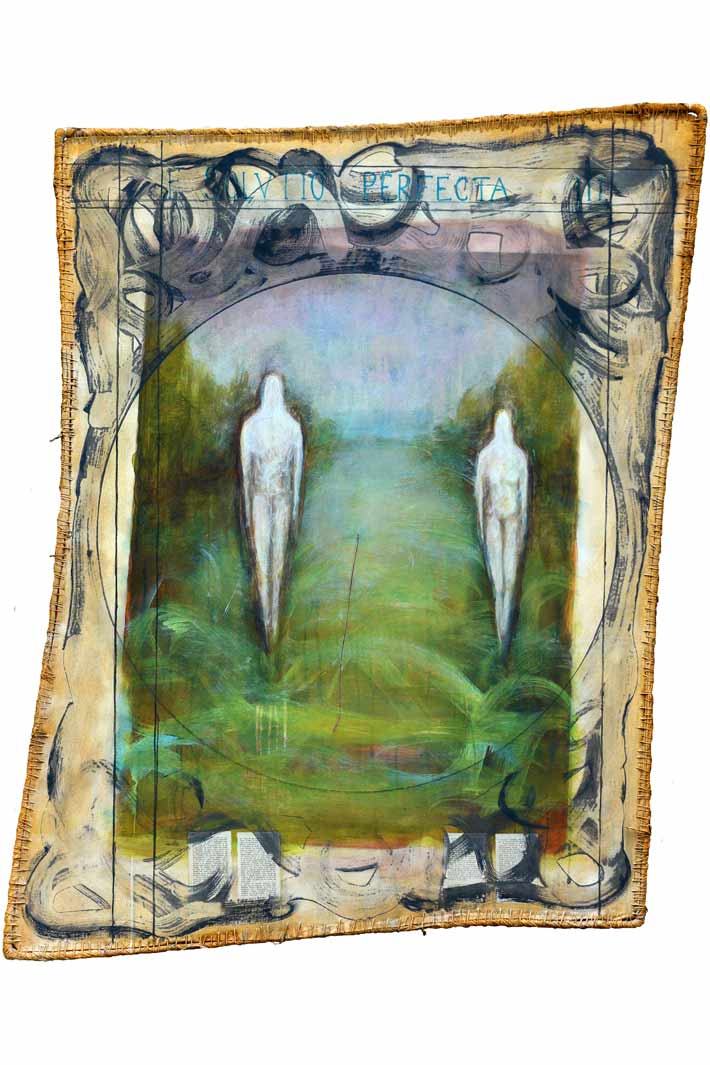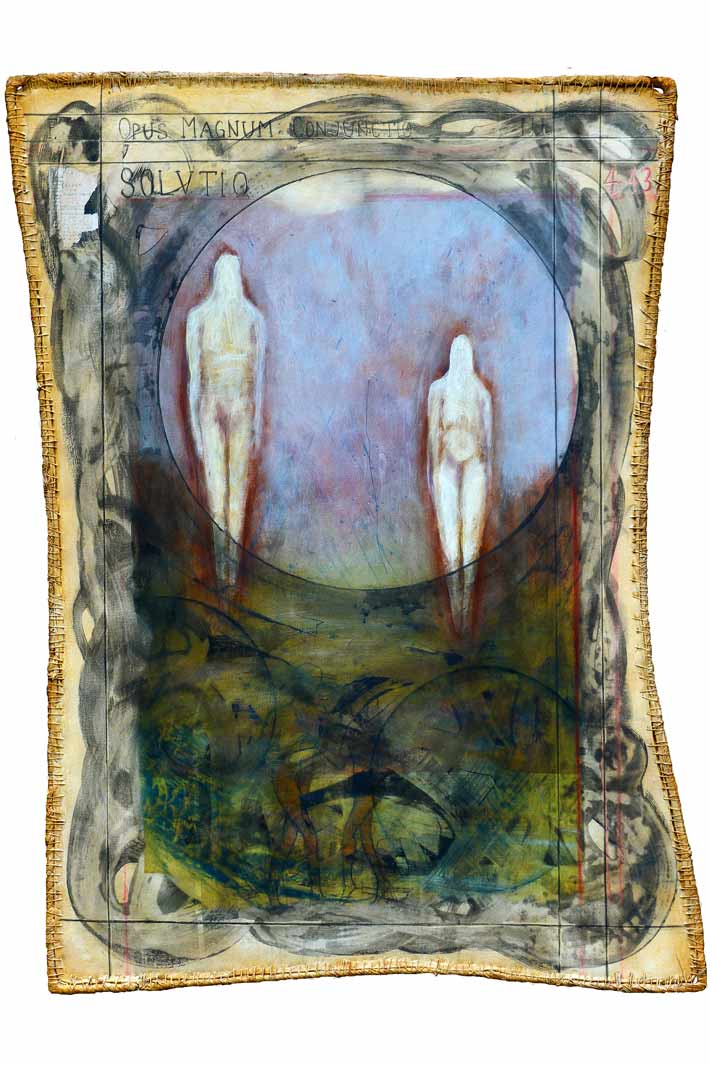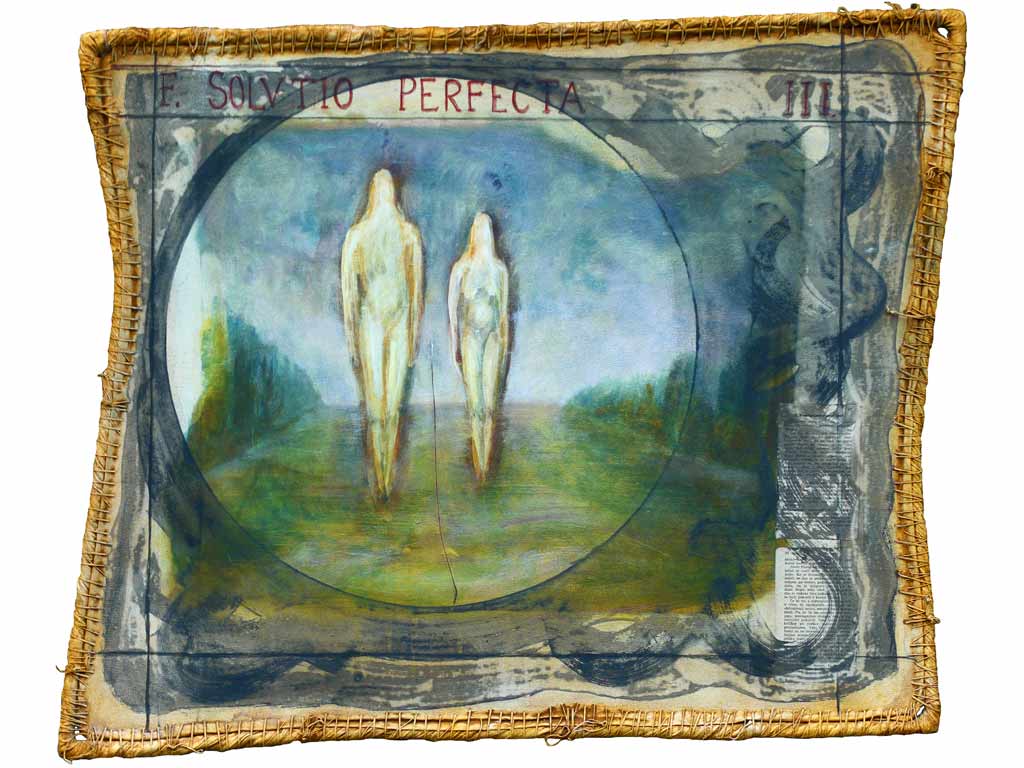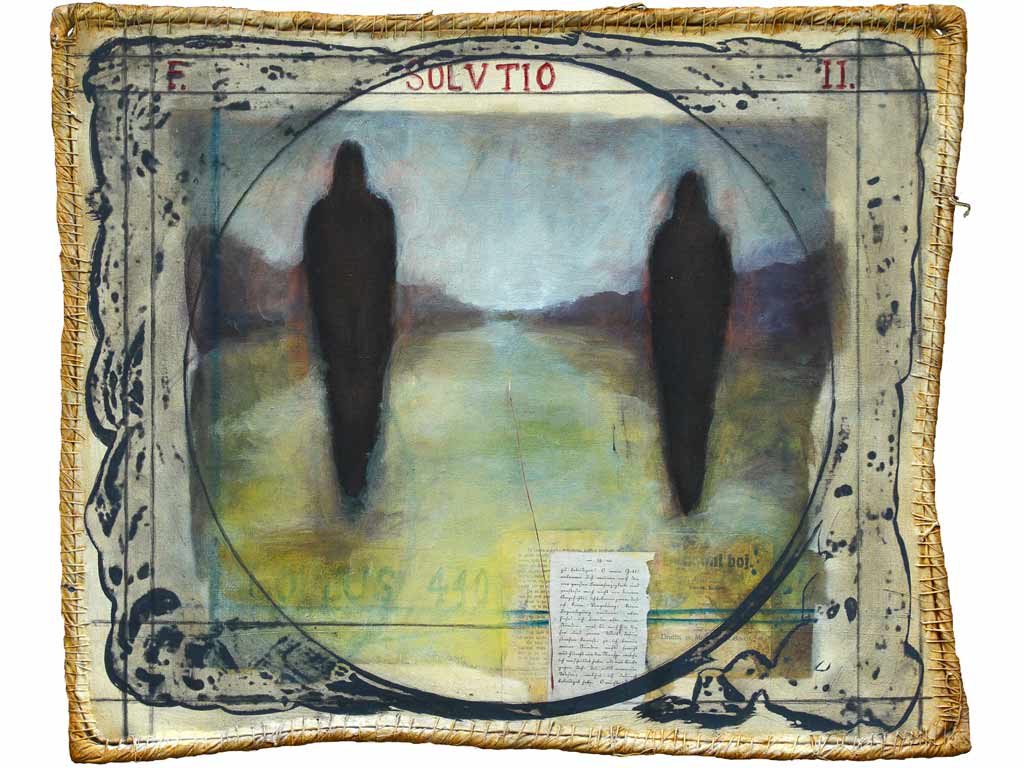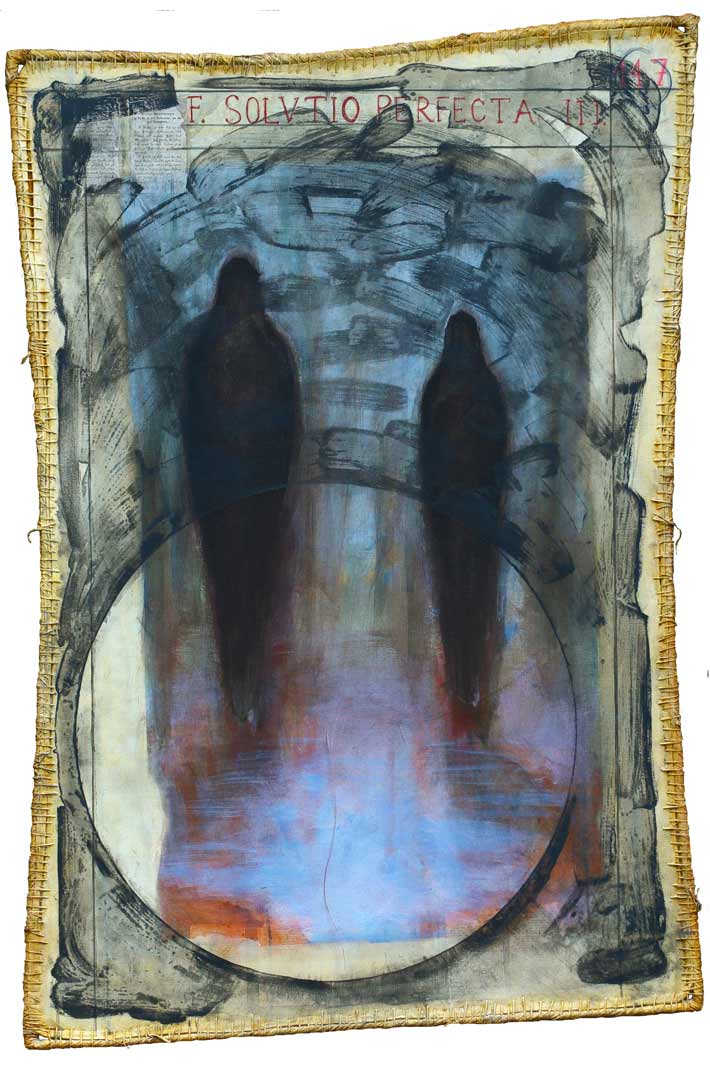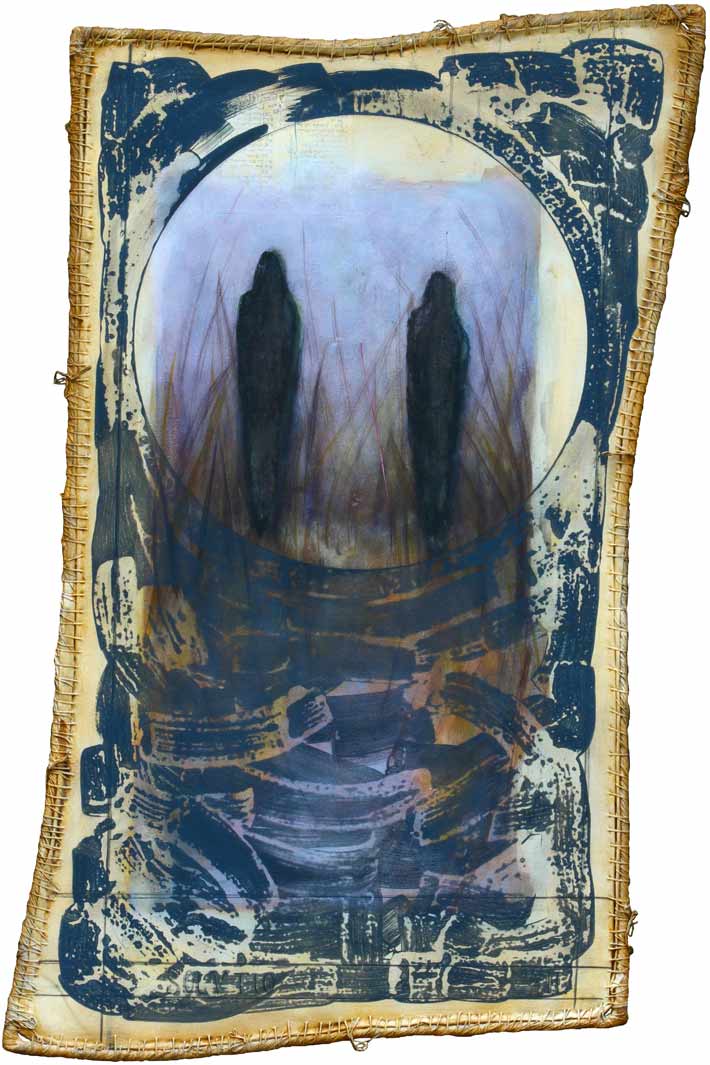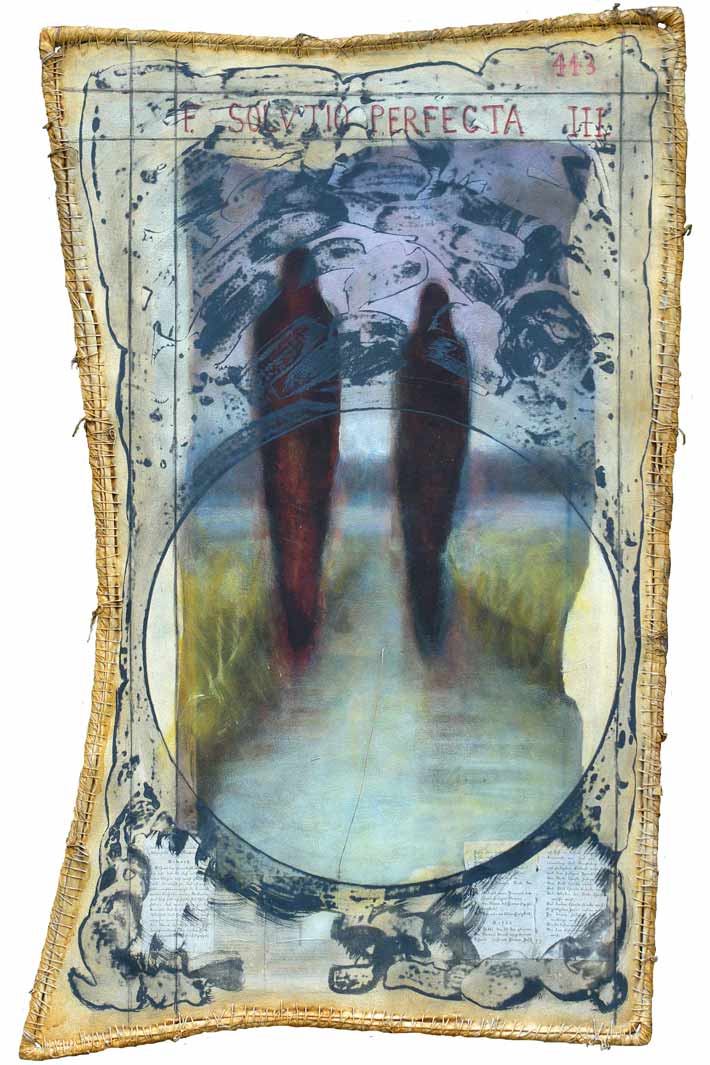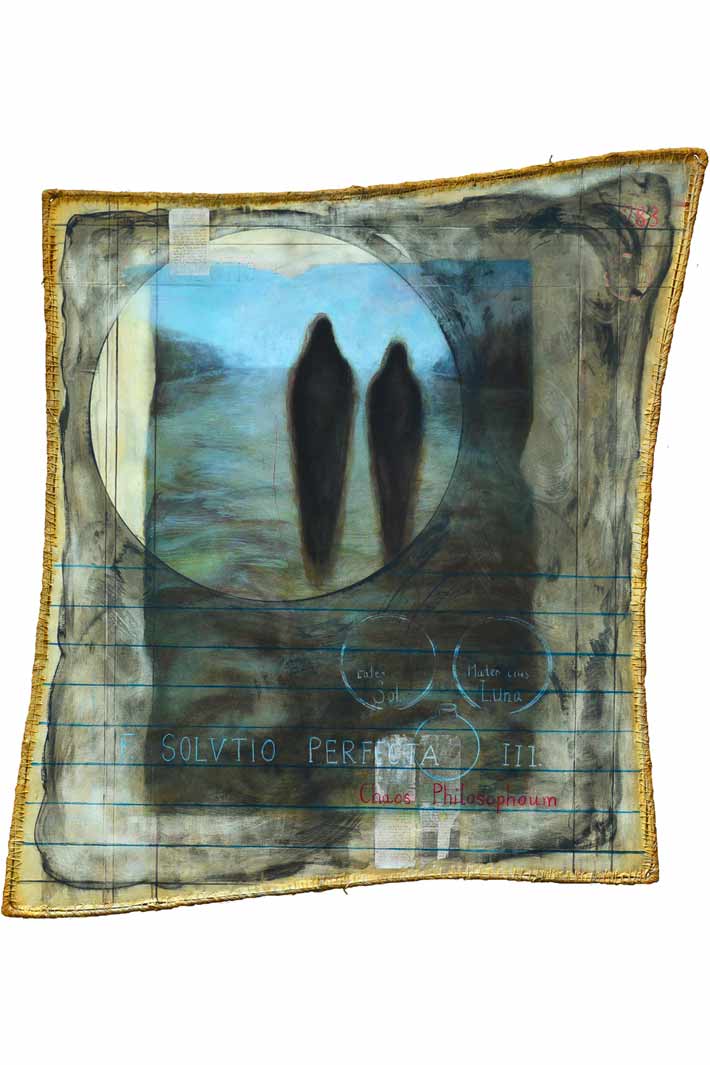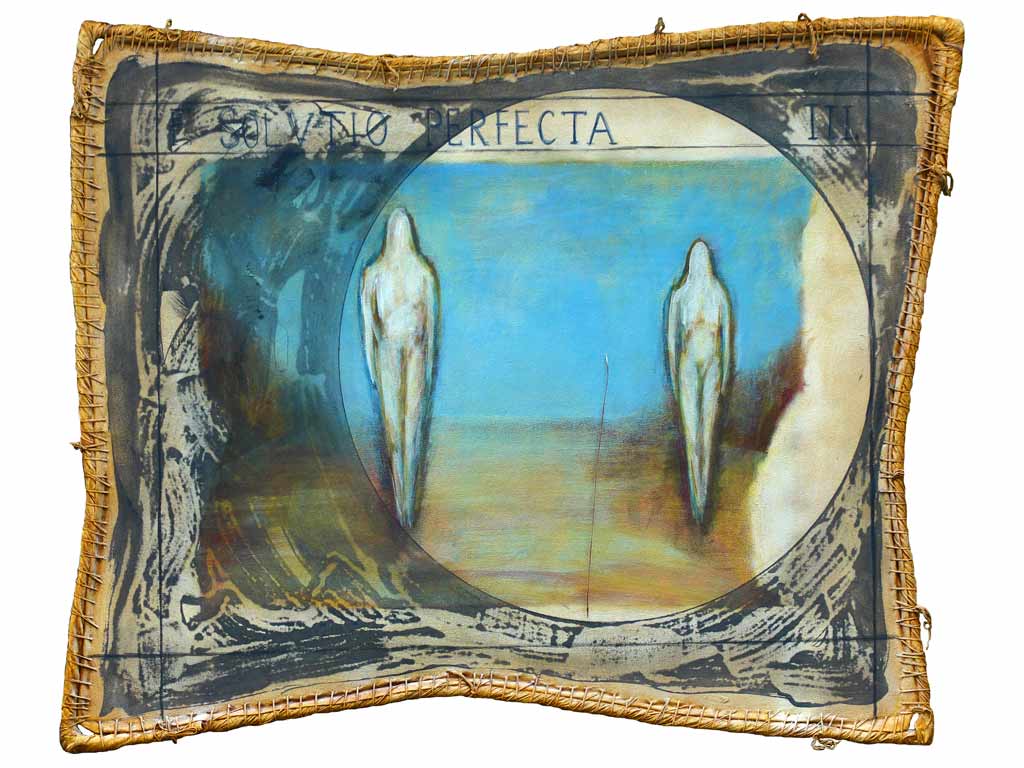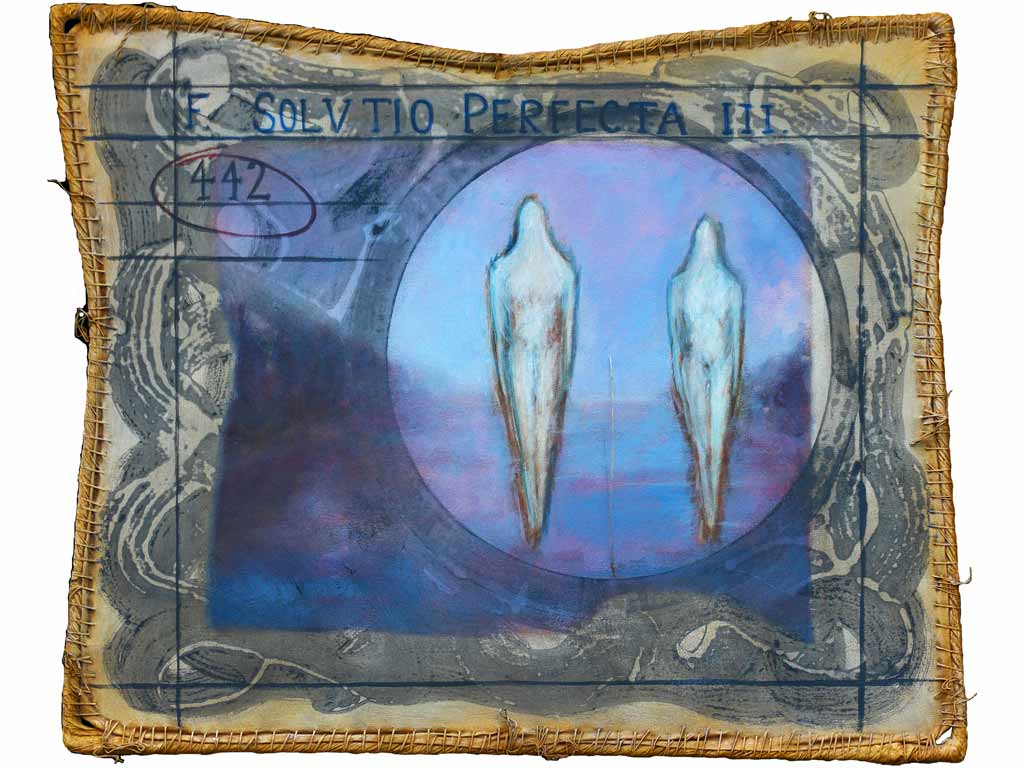... atmosphere was twilit and dangerous, its topography aggravated with mirrors; the main events were taking place on the other side of the amalgam, within some abandoned palazzo.[1]
For the last twelve and a half years I am painting on canvases that are attached on metal frames with visible seams. Therefore, my painting canvases give the impression of something archaic and primal already the very first moment you look at them. Since the beginning of my artistic path, I am predominantly engaged with transiency of life. During the last years, the aspect of transiency featured on paintings is not being portrayed as a narrative and a motif or content, but is rather becoming a part of the artist's painting style. The painting technique alone is literary riddled with destruction and impermanence. After finishing the paintings, I cover them with "ashes" (a precise mixture of white and black pigment). My last cycle of paintings bears the common title Cinis Cinereum, which means the ash of ashes and reflects the usage of pigment mixture. During this process, I leave it up to the material itself to reveal or obscure parts of the paintings. This step of destruction or receding of images is (usually) most certainly accomplished through time. But in my last painting undertaking, I rearrange time; I shrink and accumulate it into a painting process. Not only do impermanence and transformation offer the answer to the question "What is depicted" but also answer the question "How it is depicted". Speeding up time somehow strips the paintings of their saturation with content. Such conscious acceleration of time and consequently the aging of painting's life essence are achieved with painting materials and techniques, and have in recent years become my passion. In this way, I create the past in the present, which can be seen in the paintings. My metaphysical substance fuels my creative process; I am interested in the origin of everything especially the origin of the painting process. Without the metaphysical substance the artist regards the process of painting merely as coloring of surfaces.
The sixteen paintings feature the depiction of light and dark pair of figures placed in scenery with water (river, see, lake, etc.) and a right circle. I named the paintings after the illustration Solvtio Perfecta, which is one of twelve illustrations of the early alchemical work Donum Dei.[2]
The Latin term Solutio Perfecta marks the alchemical merging and dissolving of contradictions (the sun and the moon, man and woman, spirit, matter, wet and dry, etc.). Titles of individual paintings bare the names of palaces in Venice. To capture the atmosphere of the painting offers the following quotation from the essay by Joseph Brodsky, regarding the depiction of Venice:" ... atmosphere was twilit and dangerous, its topography aggravated with mirrors; the main events were taking place on the other side of the amalgam, within some abandoned palazzo."[1]
[1] Joseph Brodsky, Watermark, p. 37, 1992, HarperCollinsCanadaLtd
[2] Pretiossimum donum dei, British Library, M.S. Harley 6453; an early alchemical work from the 15th century, with a series of 12 chapters.
(Natalija Šeruga, May 2016)
Historic Mercury Amalgam Mirrors: History, Safety and Preservation*
Kathleen Payne de Chavez
Large mirror-plates are now the indispensable ornaments of every large and sumptuous apartment; they diffuse luster and gayety round them, by reflecting the rays of light in a thousands lines, and by multiplying indefinitely the images of objects placed between opposite parallel planes. — Ure’s Dictionary (1856)
History
While ancient civilizations, including the Romans, Mayans, and Egyptians, employed highly polished metal discs as mirrors, what we understand as a modern mirror, a glass with a reflective metal-foil backing, came into being sometime around the end of the 15th century. In Venice the development of cristallo, a transparent, colorless glass, gave Venetian glassmakers an advantage in the creation of high-quality mirrors with clear reflectance. Initially, some glassmakers poured a mirroring mixture of lead and antimony onto the surface of highly polished blown-glass plates, but this method yielded a rough surface with dim reflection. In the early 16th century, the Del Gallo glassmakers of the Venetian island of Murano improved the method by developing a mercury-tin amalgam technique for mirroring the glass surface. This method deposited a thin layer of tin on the surface creating unparalleled reflectance. So revolutionary was this technique that the Republic of Venice forbade Muranese glassmakers from emigrating and taking their trade secrets to other regions. However, by the mid-seventeenth century some of these skilled craftsmen had escaped and brought the trade to France, and from there, the world.
Despite the appearance of a competing mirror-making process, mercury-tin amalgam remained the predominant form of mirroring through the 19th century. Many of the lovely historic mirrors displayed in museums, historic houses, and private collections are mercury-tin amalgam mirrors. With their beauty comes subtle deterioration over time, particular preservation issues, and a necessity for certain handling precautions as some mercury remains a part of the object.
Fabrication
Though small details may have varied and changed over time, the basic principles of the mercury-tin manufacturing process remained the same for four hundred years. [see Fig. 1 below] The historic mercury-tin amalgam mirroring process begins with a plate of clear glass. Originally molten glass was blown and spun into a cylinder that was cut into a rectangular sheet, yielding a plate no larger than four-by-two feet (1.22-by - 0.58 meters). With the advent of the glass-casting method in the late-seventeenth century, glassmakers achieved plates measuring up to nearly nine-by-five-feet (2.69-by-1.63 meters). The glass was polished with a variety of successively finer abrasives to remove surface imperfections, a process originally done by hand, until, in the 1850s, machines were developed to grind and polish the surfaces of the plates. A piece of thin tin foil, slightly larger than the glass plate, was brushed onto the surface of a very smooth, lipped table, typically made of marble. Using brushes and what Ure’s Dictionary described as “woollen stuff,” liquid mercury was applied to the surface of the foil. The tin dissolved into the mercury to form a mercury-tin alloy or amalgam. Corrosion products and impurities were removed from the surface using brushes or linen cloths. The glass plate was carefully lowered into place in one smooth motion, taking care not to tear the foil. Glassmakers then placed heavy weights on the glass to achieve intimate contact between glass and amalgam.
The table was adjusted to a slight incline, allowing excess mercury to pour off. The newly formed mirror was then transferred to a wooden drying table, which could be progressively tilted a bit each day, for a period of eighteen to thirty days, until the mirror was completely vertical. At this point, most excess mercury was drained off or evaporated. The tin-foil sheet was trimmed, and the back of the mirror was sometimes varnished or painted to protect the metallic layer.
Structure/deterioration
The foil used in the fabrication of historic mirrors is predominantly tin but may be an alloy containing small percentages of lead, antimony or copper. The reflective amalgam of a mercury-tin mirror consists of tin-rich metallic crystals with a mercury-rich liquid phase filling the voids between the crystals. The mercury combined with the tin forms an unstable binary alloy, generally in a proportion of approximately seventy-five percent tin and twenty-five percent mercury. Ingenious as this mercury-tin amalgam method is, it is also inherently unstable. Over time, the liquid phase migrates to the bottoms of mirrors displayed vertically, mercury evaporates out of the amalgam, and the solid phase crystals grow and corrode. The concentration of excess mercury can cause damage along the lower portions of mirrors. Corrosion of the metallic solid phase results in the loss of the characteristic reflectance in affected areas, and the release of liquid mercury, which migrates and evaporates.
Not all historic mirrors were made with the mercury-tin amalgam process. In 1835, German chemist Justus von Liebig developed a chemical method of depositing metallic silver on glass. Mercury-tin mirrors and silvered mirrors have a somewhat similar appearance, and co-existed until the silvering process won out in the early-twentieth century. Distinguishing between the two processes can be challenging. Upon close examination, one will note that the historic glass of both types of mirrors is generally thicker than modern glass and is often darker in tonality. A thin piece of white paper placed over an historic mirror will generally appear brighter over a silvered mirror than a mercury-tin amalgam mirror.
As their metal mirroring-layer corrodes, silvered mirrors develop the warm, yellow-brown tone associated with tarnishing, while mercury-tin mirrors adopt the bluish color of tin oxides. Silvered mirrors were almost always varnished or painted to protect the readily tarnished silver, while mercury-tin mirrors generally were only painted or varnished for use in humid areas and at sea. A less-definitive indication of a mercury-tin mirror may be a tendency for a higher concentration of deterioration along the lower half of the mirror, caused by the migrating mercury. [see Fig. 2 below] T his deterioration creates holes of mirroring loss and a darkened, speckled appearance where the spaces between the metallic crystals become larger and more visible. [see Fig. 3 below]
Safety
Mercury is an acutely toxic substance, and mercury vapor readily enters the bloodstream when inhaled. From the lungs it is carried in the red blood cells to all the tissues of the body. In high concentrations, mercury can severely damage the lungs, brain, and kidneys. Its toxicity has been recognized since antiquity, and the Renaissance physician Paracelsus noted that the dose of exposure is crucial for determining whether mercury can aid in the curing of a disease or become a poison itself. Mercury vapor and its effects on the human body have been studied extensively due to the use of mercury amalgams in dentistry for the filling of cavities, and for the establishment of occupational hazard standards for those who work with mercury professionally.
As early as 1713, the ill effects of mercury vapor on professionals, including mirror-makers, were well known: “At Venice on the Island called Murano where huge mirrors are made, you may see these workers gazing with reluctance and scowling at the reflection of their own sufferings in their mirrors and cursing the trade they have adopted.” (Ramazinni, Disease of Workers, quoted in Clarkson)
Fortunately for most museum professionals or collectors, mercury-amalgam mirrors are not a serious source of mercury vapor and are thus not considered a health hazard. When Danish conservator Per Hadsund tested rooms covered from floor to ceiling with amalgam mirrors for mercury vapor content, he found them to be well below acceptable safety-limit levels.
In the case of amalgam mirrors, the movement of liquid mercury is the greater potential health risk. Liquid mercury can bead up in the bottom edge of a mirror frame between the mirror glass and the backing board or dust cover. Dust or debris that comes into contact with the liquid mercury must be treated as mercury waste. Vacuums should never be used in the removal of the accumulated liquid mercury or dust from these objects, as this can result in mercury vapor being released into the air. When considering the removal of a backing board or dust cover from an amalgam mirror, it is always best to seek professional conservation assistance.
Preservation
Mercury-tin amalgam mirrors are lovely historic artifacts and are often housed in gorgeous gilded wooden frames. It is a truly worthwhile endeavor to invest time and resources in their preservation. As inherently unstable objects, they have a finite lifespan, but a controlled environment and careful handling can go a long way to add to their longevity. Many have survived for several hundred years, and when properly cared for will outlive their caretakers, perhaps even last another two to three hundred years.
The amalgam is an ever-changing material. It is fragile and its reflective properties depend on the co-existence of both the liquid and solid phases of the amalgam. It can be tempting to flip a mirror in which much of the liquid mercury has gathered along the bottom portion, but this would only cause further damage by flooding the drier crystalline areas with the liquid, resulting in additional, highly unpredictable consequences. Care should be taken to keep the mirror in its original orientation, and an amalgam mirror, frame or no, should always be handled with the hands protected in nitrile, vinyl or other appropriate gloves. T his protects the user from the mercury in the object and the object from the corrosive salts on the skin.
Of critical importance for the preservation of mercury-tin amalgam mirrors is an environment with stable temperature and relative humidity. Lower temperatures slow the chemical reactions and rate of change of the amalgam.[1] A lower relative humidity environment is ideal but can be difficult to accommodate if the mirror is housed in a wooden frame.[2] It is important to keep the verso of the mirror free of dust, debris and spider webs that can trap and hold moisture and corrosive salts to the surface of the amalgam layer. A paper or closely woven fabric dust cover adhered across the back of the frame beneath the original wooden backing boards can prevent dust accumulation and insect nesting against the fragile surface. If you notice any changes or deterioration on an historic mirror in your collection and have questions about its long-term preservation, contact a trained conservator for additional information.
*(Kathleen Payne de Chavez; Historic Mercury Amalgam Mirrors: History, Safety and Preservation, Williamstown Art Conservation, Art Conservator | Spring 2010, Center Tech Notes.)
Notes:
[1] The low temperature limit for amalgam mirrors is 18.5F (-7.5C), while the high temperature limit is 136.4F (58C). (Hadsund 1992)
[2] Gilded wooden frames tend to be stable at a relative humidity set point anywhere between 40 percent and 55 percent, with fluctuations of no more than ±5 percent around this set point.
References:
- Thomas Clarkson; 2002. The Three Modern Faces of Mercury, in Environmental Health Perspectives. 110 (1): 11-23.
- Per Hadsund; 1992. The tin-mercury mirror: its manufacturing technique and deterioration processes, in Studies in Conservation. 38: 3-16.
- Liz Karen Herrera Quintero, et. al.; 2008. Studies of deterioration of the tin-mercury alloy within ancient Spanish mirrors, in Journal of Cultural Heritage. 9: e41-e46.
- Bernardino Ramazinni; 1964. Disease of Workers. 1713. Reprint (Wright WC, transl ). New York: Hafner Publishing Co. [Quoted in Clarkson, 2002]
- Andrew Ure, M.D.; 1856. A Dictionary of Arts, Manufactures, and Mines; containing a clear exposition of their principles and practice, Vol. DIV. III. New York: D. Appleton and Company.
Figures: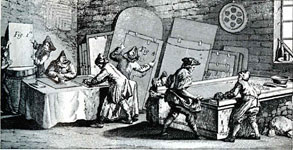
Figure 1; From Diderot Encyclopedia: The Complete Illustrations 1762–1777. Harry N. Abrams Inc. Publishers, 1978
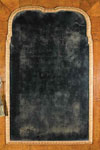
Figure 2

Figure 3
